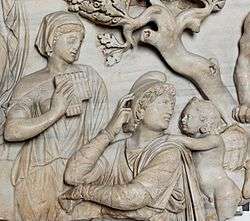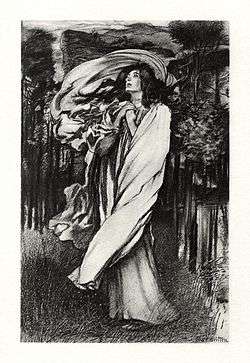Oenone
In Greek mythology, Oenone (/ɪˈnoʊniː/; Ancient Greek: Οἰνώνη Oinōnē means "wine woman") was the first wife of Paris of Troy, whom he abandoned for the Queen Helen of Sparta. In Jean Racine's play Phèdre, the name Oenone is given to Phaedra's nurse. (Note that Oenone was also the ancient name of an island, which was later named after Aegina, daughter of the river god Asopus.)

Biography
Oenone was a mountain nymph (an oread) on Mount Ida in Phrygia, a mountain associated with the Mother Goddess Cybele, alternatively Rhea. Her gift of prophecy was learned from Rhea.[1] Her father was either the river-gods, Cebren[1][2] or Oeneus.[3] Her very name links her to the gift of wine.
Mythology
Paris, son of the king Priam and the queen Hecuba, fell in love with Oenone when he was a shepherd on the slopes of Mount Ida, having been exposed in infancy (owing to a prophecy that he would be the means of the destruction of the city of Troy) but rescued by the herdsman Agelaus. The couple married, and Oenone gave birth to a son, Corythus.
When Paris later abandoned her to return to Troy and sail across the Aegean to kidnap Helen, the queen of Sparta, Oenone predicted the Trojan War. Out of revenge for Paris' betrayal, she sent Corythus to guide the Greeks to Troy. Another version has it that she used her son to drive a rift between Paris and Helen, but Paris, not recognizing his own son, killed him.
The only extensive surviving narration of Oenone and Paris is Quintus Smyrnaeus, Posthomerica, book X.259-489, which tells the return of wounded Paris to Oenone.[4] Mortally wounded by Philoctetes' arrow, he begged Oenone to heal him with her herbal arts,[5] but she refused and cast him out with scorn, to return to Helen's bed, and Paris died on the lower slopes of Ida. Then, overcome with remorse, Oenone, the one whole-hearted mourner of Paris, threw herself onto his burning funeral pyre, which the shepherds had raised. A fragment of Bacchylides suggests that she threw herself off a cliff,[6] in Bibliotheke it is noted "when she found him dead she hanged herself," and Lycophron imagined her hurtling head first from the towering walls of Troy. Her tragic story makes one of the Love Romances of Parthenius of Nicaea.[7]
Ovid includes an imagined reproachful letter from Oenone to Paris in his collection Heroides,[8] a text that has been extended by a number of spurious post-Ovidian interpolations, which include a rape of Oenone by Apollo that is nowhere confirmed in other sources.[9]
In literature
"Oenone and Paris" (1594) is an epyllion by Thomas Heywood. Lawrence Binyon published a one-act closet tragedy in blank verse "Paris and Oenone" in 1906. William Morris retold Paris's pleading Oenone to heal him in "The Death of Paris" in The Earthly Paradise.
Tennyson adapted Quintus' treatment of the theme for "The death of Oenone" (1892), distilling its tragic essence.[10] This was Tennyson's second attempt at a poem on this subject; his previous, 1829 attempt, "Oenone", was critically panned.[11]
Oenone is also mentioned in H.D.'s book-length poem, Helen in Egypt.
Letitia Landon includes a villa 'on whose frescoed walls was painted the story of Œnone' in Giulietta - A tale of the Fourteenth Century.
In Isak Dinesens short story "The Ghost Horses" the main character is called Oenone.
In popular culture
- The Misjudgment Of Oenone is a play by Michael R. McGuire.
- In Peter F. Hamilton's Night's Dawn trilogy, one of the voidhawks is called Oenone.
- A character in Philip Reeve's Mortal Engines Quartet, Oenone Zero, is named after her.
- A song in Pink Floyd's album Zabriskie Point is named after her.
- Minor planet 215 Oenone is named after her.
References
| Wikimedia Commons has media related to Oenone. |
- Pseudo-Apollodorus, Bibliotheke, 3.12.6; on-line English translations of the relevant Classical references are at The Theoi Project.
- Chisholm, Hugh, ed. (1911). . Encyclopædia Britannica (11th ed.). Cambridge University Press.
- Robert Graves. The Greek Myths, section 159 s.v. Paris and Helen
- On-line text
- "Oenone, skilled in drugs". according to Lycophron, Alexandra, 61.
- Bacchylides, fr. 20D
- Parthenius, 4.
- Heroides v.
- Sergio Casali, reviewing The Cambridge Heroides in The Classical Journal 92.3 (February 1997, pp. 305-314) pp306-07.
- Tennyson dedicated his poem to the classical scholar Benjamin Jowett as "a Grecian tale retold" and in his Memoirs (ii.386) credited it with being "even more strictly classical in form and language than the old", as Wilfred P. Mustard noted in The American Journal of Philology 23.3 (1902), p 318. See "The death of Oenone" Archived 2007-06-09 at the Wayback Machine
-
- Thorn, Michael. (1992) Tennyson, p. 106. New York: St. Martin's Press.
